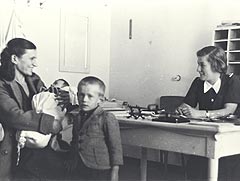An Evolving NHS
In a booklet commemorating the 50th Anniversary of the NHS in Scotland, a comparison was made between the modern service and the more rudimentary organisation that was brought to life in 1948. They had as much in common, it was said, as Concorde has with a child's kite.
A decade on, the NHS is continuing to treat record numbers of patients while Concorde is a museum piece. This is further proof of the enduring strength of the NHS and its ability to change and adapt to the demands placed upon it.
That indeed has been the real story of the past 60 years. Tests and treatments are now carried out routinely in the NHS every day that would have stunned previous generations. Innovations like transplant surgery or heart by-passes once seemed like science fiction but have now become standard.
The figures tell the story. In 1948 NHS hospitals treated 383,000 patients and 1.2 million were seen as outpatients. Today, the NHS treats almost 1.3 million inpatients every year and sees 4.4 million in outpatients or accident and emergency units. It is achieving much more for many more people.
That causes pressures, something which has become all too familiar. The pioneers of the service believed that a national health service would mop up illness, people would become healthier and costs would come down. It never happened. Within four years prescription and dental charges were introduced and they are still there today, however, prescription charges will be phased out in Scotland over the next three years and will be fully abolished by 2011.
Organisational change has been an all too common feature. The "consensus" management approach of the 1970s gave way to general management which paved the way for self-governing trusts and internal competition between hospitals, supported by GP fundholding. Competition was then abandoned in favour of collaboration leading to the strengthened partnership working of today. The constant complaint, particularly from staff, has been of too much structural change.
Meanwhile NHSScotland has continued to diagnose, treat and care for the population. Quality and patient safety have been given greater priority in recent years as services have been measured against agreed standards.
The result is the care given in Scotland has never been higher. A widespread programme of service redesign has also taken place in recent years which has resulted in major reductions in both waiting lists and waiting times. This process has been aided by record levels of investment.
Close links between academic and clinical medicine, between the administrative centre and the regions, between general practice and the hospital sector and the overall high level of expertise available in Scotland has produced a service in which the people of Scotland can be confident in and take pride in.
Spending on the NHS in Scotland doubled from 1999 to 2007 to over £10 billion a year and this may be looked on in years to come as something of a golden age for the service. Certainly, that level of growth will be difficult to sustain and the service faces tough challenges in the years ahead. These will come from the expansion of medical knowledge, the demands of an increasingly elderly population and ever rising public expectations of what the NHS should be able to deliver.
Bryan Christie
Health Journalist
- Further information
- Lothian Health Services Archive

"If Florence Nightingale was carrying her lamp through the corridors of the NHS today, she would almost certainly be looking for the people in charge."
Comment made in the 1983 NHS Management Enquiry which led to the introduction of general managers into the health service
